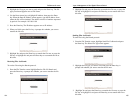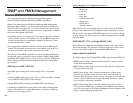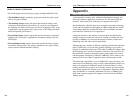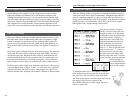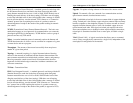
123
Layer 2 Management 4-Port Gigabit Ethernet Switch
ProConnect II
®
Series
LAN (Local Area Network) - A group of computers and associated devices
that share a common communications line and typically share the resources
of a single processor or server within a small geographic area (for example,
within an office building).
Latency - The time delay between when the first bit of a packet is received
and the last bit is forwarded.
Layer 2 - Data Link layer in the International Standards Organization (ISO)
7-Layer Data Communications Protocol, also known as the OSI (Open
Systems Interconnection) model. This is a standard model to consult when
designing network protocols. Layer 2 is directly related to the hardware inter-
face for network devices and passes traffic based on MAC addresses.
Layer 3 - Network layer in the International Standards Organization (ISO) 7-
Layer Data Communications Protocol, also known as the OSI (Open Systems
Interconnection) model. This is a standard model to consult when designing
network protocols. Layer 3 handles the routing functions for data moving
from one open system to another.
MAC (Media Access Control) Address - A unique number assigned by the
manufacturer to any Ethernet networking device, such as a network adapter,
that allows the network to identify it at the hardware level.
Mbps (Megabits per second) - One million bits per second; unit of measure-
ment for data transmission.
MDI (Medium Dependent Interface) - On a network hub or switch, a MDI
port, also known as an uplink port, connects to another hub or switch using a
straight-through cable. To connect a MDI port to a computer, use a crossover
cable.
MDIX (Medium Dependent Interface Crossed) - On a network hub or switch,
a MDIX port connects to a computer using a straight-through cable. To con-
nect a MDIX port to another hub or switch, use a crossover cable.
MIB (Management Information Base) - A set of database objects. This set
contains information about a specific device for utilizing SNMP.
Multicasting - Sending data to a group of nodes instead of a single destina-
tion.
122
Network - A system that transmits any combination of voice, video and/or
data between users.
Node - A network junction or connection point, typically a computer or work
station.
Out-of-Band Management - Management of the network from a station not
attached to the network.
Packet - A unit of data routed between an origin and a destination in a net-
work.
Packet Filtering - Discarding unwanted network traffic based on its originat-
ing address or range of addresses or its type (e-mail, file transfer, etc.).
Ping (Packet INternet Groper) - An Internet utility used to determine whether
a particular IP address is online. It is used to test and debug a network by
sending out a packet and waiting for a response.
Port - A pathway into and out of the computer or a network device such as a
switch or router. For example, the serial and parallel ports on a personal com-
puter are external sockets for plugging in communications lines, modems and
printers.
Port Mirroring - Port mirroring, also known as a roving analysis port, is a
method of monitoring network traffic that forwards a copy of each incoming
and outgoing packet from one port of a network switch to another port where
the packet can be studied. A network administrator uses port mirroring as a
diagnostic tool or debugging feature, especially when fending off an attack. It
enables the administrator to keep close track of switch performance and alter
it if necessary. Port mirroring can be managed locally or remotely.
Port Trunk - Defines a network link aggregation and trunking method, which
specifies how to create a single high-speed logical link that combines several
lower-speed physical links.
QoS (Quality of Service) - A wide variety of techniques that prioritizes spe-
cific types of network traffic. QoS is used to maximize a network's perform-
ance according to its requirements. QoS ensures better service to high-priori-
ty types of network traffic, which may involve demanding, real-time applica-
tions, such as videoconferencing.





